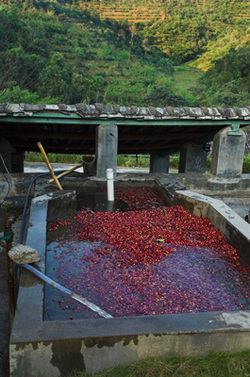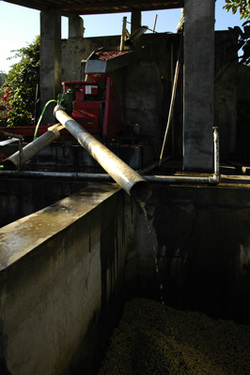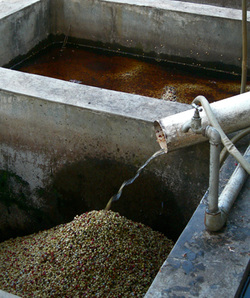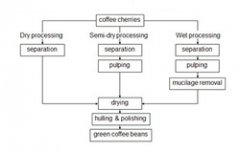Wet treatment methods and steps of Yunnan coffee beans
As the harvest season is almost over, I would like to add an overview of the coffee processing process. In this blog post, I will introduce to you the steps of wet treatment in Yunnan after coffee picking.
After harvest, the berries are either sent directly to the pulp collector (if the harvest is done well), or concentrated in a siphon tank filled with water. The berries are washed and separated in this jar. The stone sank to the bottom of the jar and was picked up by hand when the jar was emptied. Lighter berries float on the water and are removed with a hedge along with leaves and twigs. The berries suspended in the water are then recovered by a siphon and transported to the pulp collector.

The purpose of removing the pulp is to separate the pulp from the seed coat of coffee beans. The pulp is removed by squeezing the berries. Because ripe berries contain a lot of moisture, peeled coffee beans can easily pop out when the berries are squeezed.
The next step is to remove the mucus, which aims to remove the residue of the mesocarp that clings to the seed coat after the pulp has been removed (see the illustration of the various parts of the coffee berry). Because the mucus is insoluble in water and tightly attached to the seed coat, it cannot be removed by simple cleaning, so it either needs to be cleaned after fermentation or can be removed by strong friction in an equipment called a mucus remover.

In Yunnan, this process is mainly accomplished by natural fermentation. The term fermentation is not 100% accurate because there is no biochemical reaction inside the coffee beans. It is more appropriate to call this process the use of biochemical reaction or hydrolysis to remove mucus. This reaction is caused by natural enzymes in coffee berries.

The fermentation time varies from 6 hours to 72 hours, depending on the temperature, the amount of mucus and the concentration of digestive enzymes. Put the coffee in a fermentor until the mucus is completely decomposed and the beans can be washed.
The key to ensuring the quality of coffee is to stop fermentation at the right time, because excessive fermentation can lead to the emergence of so-called smelly coffee beans. If the fermentation is insufficient or too slow, butyric acid or propionic acid will be produced, both of which will adversely affect the quality of coffee.
The fermented coffee with skin needs to be cleaned immediately after the completion of the fermentation process to terminate the process. However, after removing the mucus and before cleaning, it may be necessary to soak the coffee with skin in clean water for 12 to 24 hours to reduce the bitter taste of the coffee drink.
Important Notice :
前街咖啡 FrontStreet Coffee has moved to new addredd:
FrontStreet Coffee Address: 315,Donghua East Road,GuangZhou
Tel:020 38364473
- Prev

The tasting term coffee taste of coffee
Before you begin to understand the characteristics of coffee beans in different places, you must know the following taste words in order to know the characteristics and flavor of coffee beans in various producing areas. Body (consistency) has been translated as mellow, the correct taste should be to feel the coffee after the entrance of the thick, thick texture. The tactile impression and consistency of the tongue in terms of weight and quality are as light as water.
- Next

A brief introduction to the general knowledge of fine coffee the processing process of coffee beans
Recently, the harvest of coffee has been fully spread out in Yunnan. I think it's time to pick out some of the blog posts I've posted. I've been planning this for a long time. Almost a year ago, I posted a blog called "Harvest Rewards". It's about several ways to harvest coffee in this area. The coffee fruit should be peeled within 8 hours after picking, otherwise
Related
- Guji coffee producing area of Guji, Ethiopia: Humbela, Shakiso, Wulaga
- What is the most expensive variety of Qiloso in BOP multi-variety group?
- How to store the coffee beans bought home?
- Why are Yemeni coffee beans so rare now?
- Ethiopian Sidamo all Red Fruit Sun Sun Santa Vini Coffee beans
- SOE is mostly sour? What does it mean? Is it a single bean? what's the difference between it and Italian blending?
- Is Italian coffee beans suitable for making hand-brewed coffee?
- How to choose coffee beans when making cold coffee? What kind of coffee beans are suitable for making cold coffee?
- Just entered the pit to make coffee, what kind of coffee beans should be chosen?
- Can only Japan buy real Blue Mountain Coffee? What are authentic Jamaican Blue Mountain coffee beans?

